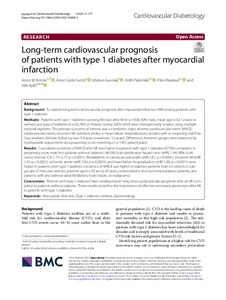Long-term cardiovascular prognosis of patients with type 1 diabetes after myocardial infarction
Kerola Anne M; Semb Anne Grete; Juonala Markus; Palomäki Antti; Rautava Päivi; Kytö Ville
https://urn.fi/URN:NBN:fi-fe2022113068373
Tiivistelmä
Background
To explore long-term cardiovascular prognosis after myocardial infarction (MI) among patients with type 1 diabetes.
Methods
Patients with type 1 diabetes surviving 90 days after MI (n = 1508; 60% male, mean age = 62.1 years) or without any type of diabetes (n = 62,785) in Finland during 2005–2018 were retrospectively studied using multiple national registries. The primary outcome of interest was a combined major adverse cardiovascular event (MACE; cardiovascular death, recurrent MI, ischemic stroke, or heart failure hospitalization) studied with a competing risk Fine-Gray analyses. Median follow-up was 3.9 years (maximum 12 years). Differences between groups were balanced by multivariable adjustments and propensity score matching (n = 1401 patient pairs).
Results
Cumulative incidence of MACE after MI was higher in patients with type 1 diabetes (67.6%) compared to propensity score-matched patients without diabetes (46.0%) (sub-distribution hazard ratio [sHR]: 1.94; 95% confidence interval [CI]: 1.74–2.17; p < 0.0001). Probabilities of cardiovascular death (sHR 1.81; p < 0.0001), recurrent MI (sHR 1.91; p < 0.0001), ischemic stroke (sHR 1.50; p = 0.0003), and heart failure hospitalization (sHR 1.98; p < 0.0001) were higher in patients with type 1 diabetes. Incidence of MACE was higher in diabetes patients than in controls in subgroups of men and women, patients aged < 60 and ≥ 60 years, revascularized and non-revascularized patients, and patients with and without atrial fibrillation, heart failure, or malignancy.
Conclusions
Patients with type 1 diabetes have notably poorer long-term cardiovascular prognosis after an MI compared to patients without diabetes. These results underline the importance of effective secondary prevention after MI in patients with type 1 diabetes.
Kokoelmat
- Rinnakkaistallenteet [27094]
